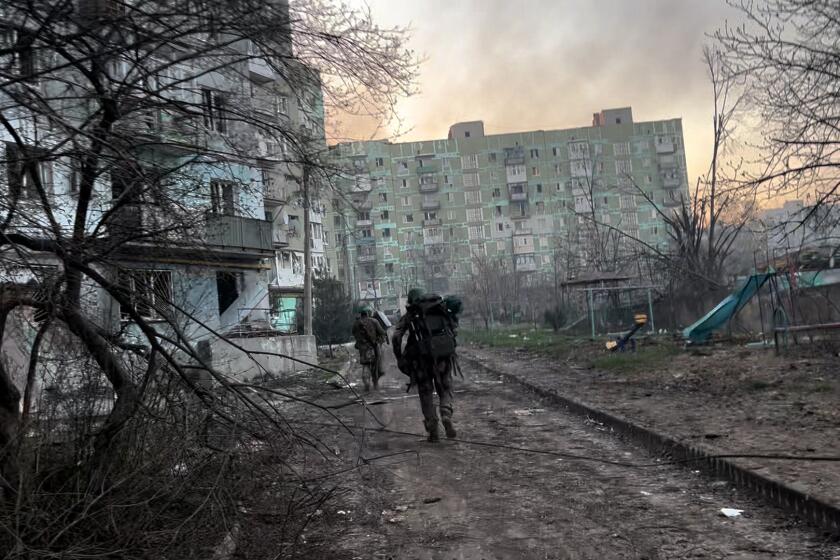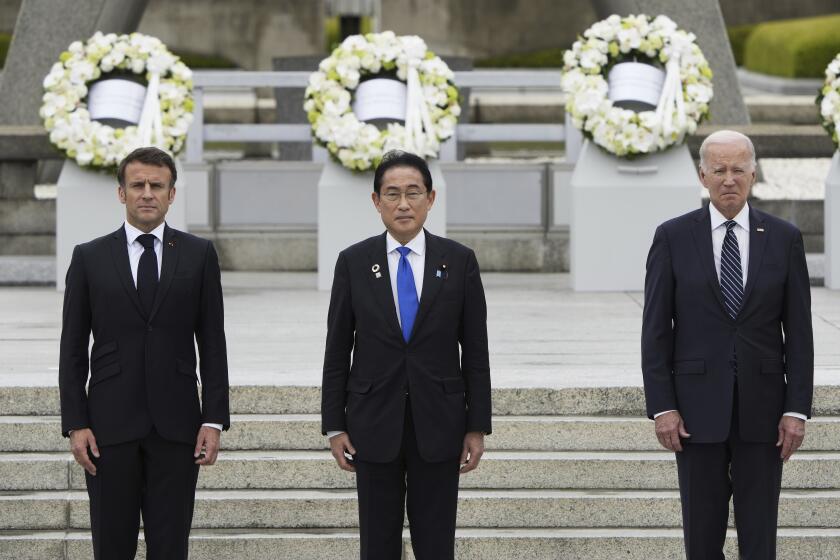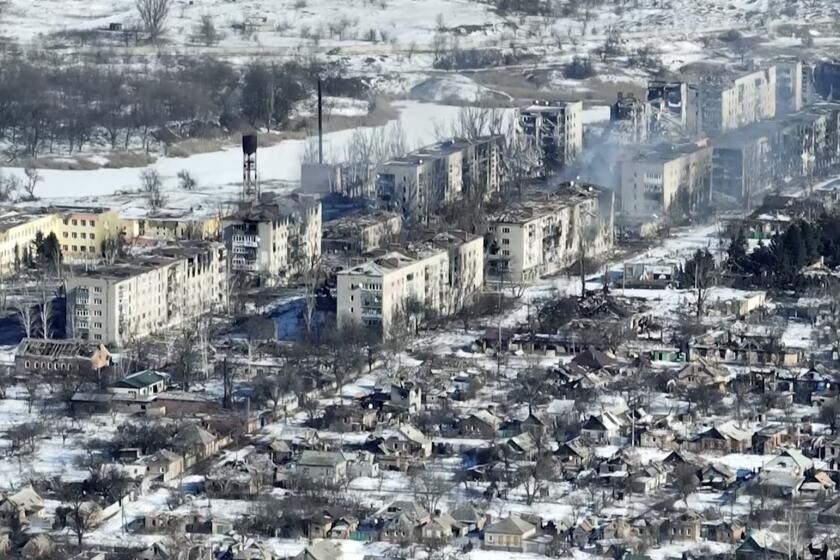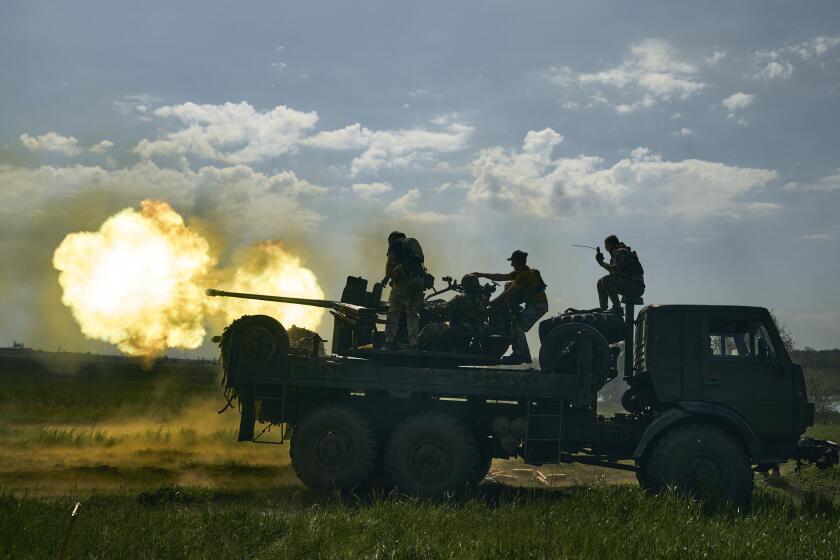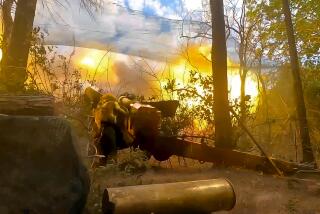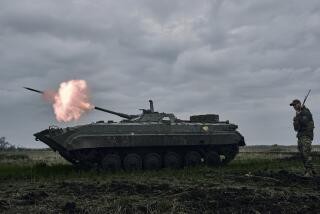Russia claims it captured Bakhmut, making comparisons to Berlin in 1945
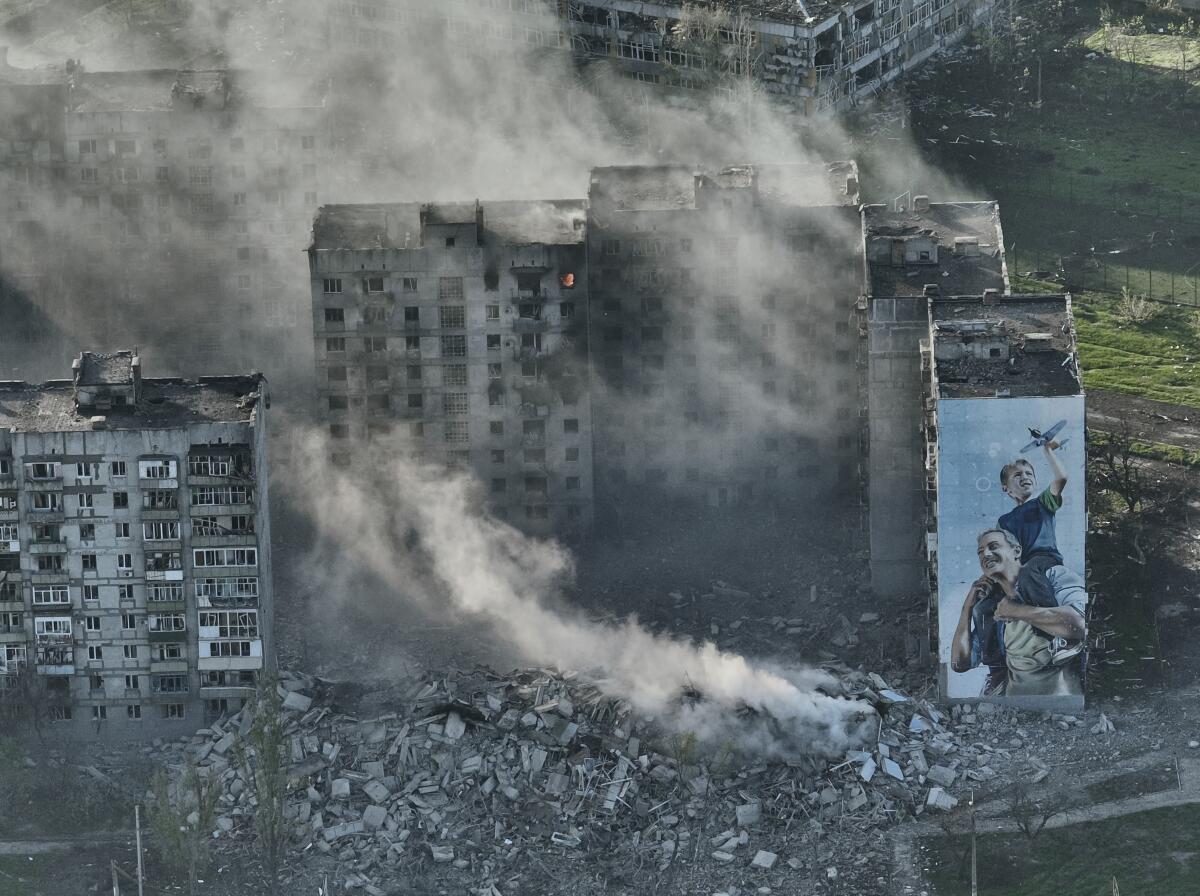
- Share via
TALLINN, Estonia — Russian TV went into a full frenzy of celebration as it reported Moscow’s capture of the Ukrainian city of Bakhmut. There were comparisons to the Red Army liberating Berlin in 1945, congratulations relayed from President Vladimir Putin and announcers emphasizing the victory by using the city’s nearly century-old Soviet name of Artyomovsk.
“The myth that Artyomovsk is an unassailable fortress has been crushed,” an anchor said Sunday night on Channel One, Russia’s most popular state broadcaster. “Those are historic events.”
A report from the smoldering city in eastern Ukraine followed, showing Russian fighters yelling “Victory!” and placing two flags — the Russian tricolor and the black flag of the private military contractor Wagner — atop a tall, partly destroyed building.
The flags were mounted “so that everyone could see them,” the correspondent said, even though the bombed-out, deserted 400-year-old city looks like a ghost of itself after the longest and bloodiest battle of the war.
If war is hell, there’s a credible case Bakhmut is its ninth circle, as Russia besieges the Ukrainian city that has symbolic, if not strategic, value for both sides.
Despite the Russian claims, top Ukrainian military leaders say the fight there is not over, even though they still control only a small part of the city. Deputy Defense Minister Hanna Maliar said Monday that Ukrainian troops hold parts of its southwestern outskirts, while fighting continues for the strategic heights in the northern and southern suburbs.
But Kyiv says its troops played a key role in the strategy of exhausting Russian forces. Tens of thousands of fighters on both sides have died in the grinding nine-month battle for Bakhmut.
Satellite imagery shows infrastructure, apartment blocks and buildings reduced to rubble from relentless artillery attacks.
Putin badly needed a victory in Bakhmut, analysts say, especially after a winter offensive by his forces failed to take other front-line cities and towns. And Russia still wants to capture the entire Donetsk region — a goal that was emphasized several months after the assault on Kyiv failed.
On Channel One, a Russian fighter told the correspondent he felt “probably the same emotions our grandfathers had in Berlin,” referring to the Red Army’s victorious sweep of the German capital at the end of World War II.
President Biden has endorsed plans to train Ukrainian pilots to fly F-16s, officials say, clearing the way to arm Kyiv with the U.S.-made fighter jets.
A similar segment on Russia 1, another major state TV channel, saw a correspondent proclaim that “the fight for Bakhmut ended in defeat” for Ukraine. Now Russian forces can advance toward the cities of Siversk, Kostyantynivka and Kramatorsk, and even the southeastern city of Dnipro, she said.
Two pro-Kremlin tabloids came out with headlines Monday celebrating the reported capture of the city.
“Bakhmut is taken. What next? The city has again become Artyomovsk,” said a bright red headline on the front of Komsomolskaya Pravda.
Moskovsky Komsomolets went even further and called it, “The Artyomovsk turning point,” noting beneath that “The Ukrainian Armed Forces failed to hold onto their important fortress city, Bakhmut.”
A column on the state news agency RIA Novosti touched on the strategic value of Bakhmut, saying 224 days of fighting allowed Russia “to grind up the best divisions of the Ukrainian Armed Forces and destroy their equipment on an industrial scale.”
Drone video of Bakhmut shows how the longest battle of Russia’s yearlong invasion has reduced the holdout mining city in eastern Ukraine to a ghost town.
“This was its strategic value for us,” RIA Novosti columnist Viktoria Nikiforova wrote. “This forced Ukrainian handlers to delay their ‘counteroffensive’ for months, and gave our forces time to prepare for repelling it,” she wrote, countering Western arguments that Bakhmut held little strategic importance for Russia.
The celebratory tone continued Monday even as Russia reported an incursion into its territory in the border region of Belgorod by Ukrainian saboteurs, triggering a “counterterrorism operation.”
Kremlin spokesman Dmitry Peskov said the attack was meant “to draw attention away from the Bakhmut axis, to minimize the political effect of Ukrainian side losing Artyomovsk.”
The fog of war made it impossible to confirm the situation inside Bakhmut, with President Volodymyr Zelensky saying the city was not fully occupied.
In a video on Telegram, Wagner head Yevgeny Prigozhin said the city came under full Russian control about midday Saturday, proclaiming it “completely taken” as he held a Russian flag with a group of at least nine masked fighters in body armor and heavy weapons. Prigozhin had feuded publicly with Russian Defense Minister Sergei Shoigu over adequate supplies of munitions to Wagner’s private forces.
Start your day right
Sign up for Essential California for the L.A. Times biggest news, features and recommendations in your inbox six days a week.
You may occasionally receive promotional content from the Los Angeles Times.
About 35 miles north of the Russian-held regional capital of Donetsk, Bakhmut was an important industrial center, surrounded by salt and gypsum mines and home to about 80,000 people before the war, in a country of more than 43 million.
The city was named Artyomovsk in 1924 after a Bolshevik revolutionary when Ukraine was part of the Soviet Union, and was known for its sparkling wine produced in underground caves. Its broad, tree-lined avenues, lush parks and late-19th century mansions have been reduced to a wasteland.
For Ukraine, which changed the name of the city to Bakhmut in 2016, the important factor has been the high number of Russian casualties and sapping of their adversary’s morale for the small patch of the 930-mile front line as Kyiv prepares a counteroffensive in the 15-month-old war.
“The enemy failed to surround Bakhmut. They lost part of the heights around the city. The continuing advance of our troops in the suburbs greatly complicates the enemy’s presence,” Maliar said. “Our troops have taken the city in a semi-encirclement, which gives us the opportunity to destroy the enemy.”
In recent weeks, Ukrainian forces had made significant advances near strategic roads through the surrounding countryside, chipping away at Russia’s northern and southern flanks with the aim of encircling Wagner fighters in the city.
The Ukrainian military’s surrender hotline, dubbed ‘I Want to Live,’ is enticing some Russian soldiers to quit the battlefield as the war drags on.
Nearly 8 square miles of territory were recaptured, Maliar said last week. Hundreds of yards more were regained almost every day since, according to Serhii Cherevatyi, spokesman for Ukraine’s Operational Command East.
Russia deployed reinforcements to Bakhmut to replenish the lost northern and southern flanks and prevent more Ukrainian breakthroughs, according to Ukrainian officials and outside observers.
Ukraine’s tactical gains in the rural area outside Bakhmut could be more significant than they seem, some analysts say.
“It was almost like the Ukrainians just took advantage of the fact that, actually, the Russian lines were weak,” said Phillips O’Brien, a professor of strategic studies at the University of St. Andrews. “The Russian army has suffered such high losses and is so worn out around Bakhmut that ... it cannot go forward anymore.”
Days before Russia announced it controlled the city, Ukrainian forces held only a handful of buildings amid constant Russian bombardment. Outnumbered and outgunned, they described nightmarish days.
Russia’s artillery dominance was so overwhelming, accompanied by continuous human waves of mercenaries, that defensive positions could not be held for long.
There has been talk for months of a spring counteroffensive by Ukraine to wrest back territory from Russian forces, but the drive has yet to begin.
“The importance of our mission of staying in Bakhmut lies in distracting a significant enemy force,” said Taras Deiak, commander of a special unit of a volunteer battalion. “We are paying a high price for this.”
The northern and southern flanks regained by Ukraine are near two highways that lead to Chasiv Yar, a town 6 miles from Bakhmut, that are key logistics supply routes. One is dubbed the “road of life.”
Ukrainian forces on this road often came under Russian fire. Armored vehicles and pickup trucks heading to the city to replenish Ukrainian troops were frequently destroyed.
With those high plains now under Ukrainian control, Ukrainian forces have more breathing room.
“This will help us design new logistic chains to deliver ammunition in and evacuate the injured or killed boys,” said Deiak, speaking from inside Bakhmut on Thursday, two days before Russia claimed the city.
Kullab reported from Kyiv, Ukraine. Danica Kirka in London contributed to this report.
More to Read
Sign up for Essential California
The most important California stories and recommendations in your inbox every morning.
You may occasionally receive promotional content from the Los Angeles Times.
